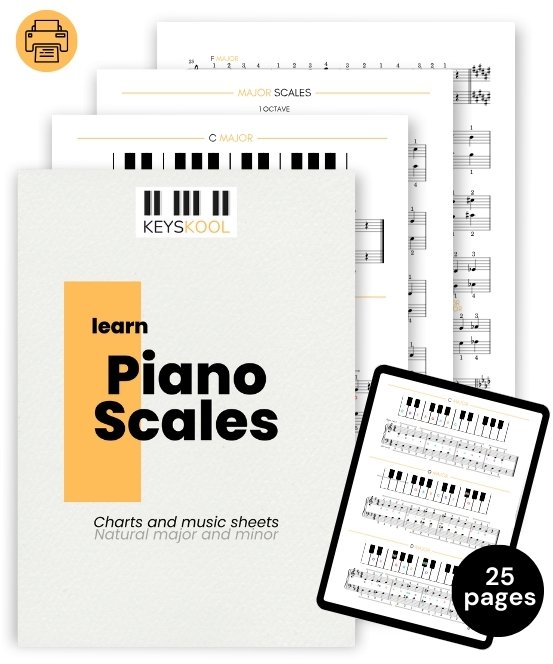Hey there, budding pianist! Just like a painter needs to understand colors, a pianist needs to understand what are piano scales. You might be thinking, “What are piano scales? Aren’t those the things fish have?” Well, you’re not entirely wrong, but in the world of music, scales are a little different! Piano scales are the building blocks of music. They are like the ABCs of the musical language.
Understanding them might seem daunting at first, but don’t fret! With patience and practice, you’ll soon be gliding up and down the keyboard like a pro, bringing beautiful music into the world. So let’s dive in, shall we? You’re about to embark on an exciting journey, and I promise, it’ll be worth every note!
What are Piano Scales Used For?
Making Sense of Music: The Role of Piano Scales
Congratulations! You’ve taken your first steps into the world of piano playing. As you embark on this musical journey, it’s time to learn about one of the most important aspects of music – piano scales.
You might be wondering, “What are piano scales used for?” Well, they’re more important than you might realize!
Piano scales are the foundation of all music. They help us understand the relationships between different notes and provide a roadmap for creating melodies and harmonies.
The Harmony Creators
Have you ever wondered how musicians create such beautiful harmonies? The secret lies in the scales. Each scale consists of a specific sequence of notes that sound harmonious when played together. This is because they share a certain mathematical relationship. When you play a scale, you are essentially playing all the notes that sound good together.
The Melody Makers
Scales also serve as the building blocks for melodies. A melody is a sequence of notes played in a particular rhythm. When you play a melody based on a certain scale, you ensure that the notes you choose will sound good together.

Improvisation and Composition Tools
As you progress in your piano journey, you might want to start composing your own music or improvising. This is where scales really come in handy. Knowing which notes sound good together takes the guesswork out of composing and improvising. You can confidently pick notes from the scale you’re working in, knowing they’ll sound harmonious.
Technical Skill and Finger Strength
Practicing scales is also a great way to develop your technical skills and finger strength. As you move up and down the keyboard, playing each note in the scale, you’re giving your fingers a fantastic workout. This will help you when it comes to playing more complex pieces of music.
What Scales Should I Learn First on Piano?

Printable Beginner piano scales ebook PDF
Discover the magic of learning piano scales easily with our ebook designed for complete beginners with notes, charts and very easy music sheets.
Mastering the Keyboard: An Introduction to What are Piano Scales
Now that you’ve got a grasp on the basics, it’s time to delve a little deeper into the world of piano scales. Remember, just like a chef needs to know their ingredients, a pianist needs to understand their scales. So, let’s uncover the mystery behind the 12 different scales on the piano, and finally understand what are piano scales?
A World of Scales

First things first, when we talk about the 12 scales on the piano, we’re referring to the 12 major scales. These scales are built on each of the 12 notes of the chromatic scale, which includes all the white and black keys on the piano.
Each major scale has a unique pattern of whole and half steps that creates a distinctive sound. Mastering these scales will not only enhance your understanding of music but will also open up a world of possibilities when it comes to playing and creating music.
Did you know? The world record for the fastest piano scale is held by Hungarian pianist Balázs Havasi, who played a scale at 498 BPM in 2012. (Source: Guinness World Records)
The Circle of Fifths
One of the first things you’ll want to familiarize yourself with is the Circle of Fifths. This handy tool is a visual representation of the relationship between the 12 tones of the chromatic scale. It’s a great way to see how different scales relate to each other and can be a valuable aid in understanding and memorizing the 12 major scales.
What are piano scales : Major Scales
Let’s start with the major scales. These scales are known for their happy, upbeat sound. They are the foundation for much of Western music, from classical to pop. Here’s a brief overview:
- C Major: This is the most basic scale, consisting of all white keys.
- G Major: This scale introduces one sharp note, F#.
- D Major: This scale has two sharps, F# and C#.
- A Major: This scale adds another sharp note, G#.
- E Major: This scale has four sharps, F#, C#, G#, and D#.
- B Major: This scale introduces five sharps.
The pattern continues with F# Major, C# Major, G# Major, D# Major, A# Major, and finally E# Major.

What are piano scales : Minor Scales
Let’s discuss the minor scales now. These scales are known for their melancholy or serious sound. Here’s a brief overview:
- A Minor: This is the most basic minor scale, consisting of all white keys.
- E Minor: This scale introduces one sharp note, F#.
- B Minor: This scale has two sharps, F# and C#.
- F# Minor: This scale adds another sharp note, G#.
- C# Minor: This scale has four sharps, F#, C#, G#, and D#.
- G# Minor: This scale introduces five sharps.
The pattern continues with D# Minor, A# Minor, E# Minor, B# Minor, and finally F## Minor.
Difference between what are piano scales and piano chords
Now, as you venture further, you’ll encounter a couple of musical terms: scales and chords. These two elements make up the foundation of all the beautiful music you hear and will soon be creating! So, let’s dive in and explore the differences between scales and chords on the piano.
The Building Blocks of Piano Music: What are Piano Scales?
Firstly, let’s tackle scales. Scales are like the DNA of music – they form the basic framework on which melodies and harmonies are built. They are sequences of notes that move step by step in an ascending or descending order. Each scale gives us a set of notes that sound harmonious when played together.
You’ve probably already come across scales such as the C Major scale, which is the simplest scale consisting of all the white keys on the piano (C, D, E, F, G, A, B). There are many other scales, each creating a unique mood and feel to the music.
“Music can name the unnameable and communicate the unknowable.”
– Leonard Bernstein
The Harmony Creators: Chords
Now, let’s move on to chords. If scales are the DNA of music, chords are the cells – they combine to create the body of a musical piece. A chord is a group of notes (usually three or more) played together at the same time.
You form chords by picking notes from a particular scale and playing them simultaneously. For example, if you pick the first, third, and fifth notes of the C Major scale and play them together, you’ve just played a C Major chord!
Scales vs. Chords: The Difference
Now you might be wondering, how do scales and chords differ? Well, scales and chords are different in terms of their structure and use in music.
The structure of a scale is like a staircase, with each step representing a note. It’s a linear sequence of notes that you play one after another, either going up (ascending) or going down (descending).
On the other hand, chords are like a single step that you leap onto. Instead of playing each note one after the other, you play several notes all at once to create a rich, layered sound.

Learning what are piano scales and chords
As a beginner, learning scales and chords might seem like a daunting task. But don’t worry! Take it one note at a time. Start with simple scales and chords, and gradually work your way up. Remember, practice is key! The more you play, the more familiar you’ll become with the patterns and sounds.
Now that you understand the difference between what are piano scales and chords, you’re ready to make beautiful music. So go ahead, sit at your piano, and let your fingers dance on the keys. Happy playing!
